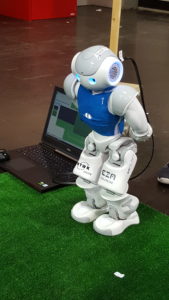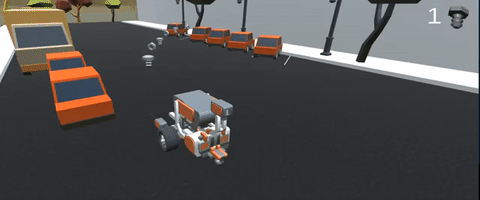Michelle Hirsch von MathWorks über die Entwicklung und den Nutzen von Autonomen Systemen
Autonome Systeme werden in naher Zukunft beinahe jeden Lebensbereich unserer modernen Gesellschaft berühren. Sie werden die Produktion maßgeblich verändern, aber sie werden auch das Arbeitsleben und Geschäftsstrategien deutlich beeinflussen, denn mit zunehmender Fähigkeit der Maschinen, uns alltägliche Dinge abzunehmen, bleiben den Menschen mehr Kapazitäten für kreative Arbeit. Was Autonome Systeme von bereits bestehenden automatisierten Systemen unterscheidet, welche Voraussetzungen für ihre Entwicklung erfüllt werden müssen und welches Potential sie mit sich bringen, ist ein Schwerpunktthema auf der diesjährigen MATLAB EXPO am 27. Juni in München. So erläutert Michelle Hirsch, Head of MATLAB Product Management bei MathWorks, diese Fragestellungen in ihrer Keynote „How to build an Autonomous Anything“.
Autonome Systeme in der Gesellschaft
„Der Begriff «Autonome Systeme» wird oft mit selbstfahrenden Autos, intelligenten Robotern oder automatisch navigierenden Drohnen in Verbindung gebracht“, meint Michelle Hirsch. „Doch Autonome Systeme haben auf ein viel breiteres Spektrum unseres täglichen Lebens Einfluss – etwa in Form einer Erntemaschine, die 300 Tonnen Getreide pro Stunde erntet und gleichzeitig in einen nebenherfahrenden Container ablädt. Dank Autonomer Systeme kann eine Gaspumpstation mit Predictive-Maintenance-System Schwachstellten erkennen und melden, bevor es zum Schaden kommt. Es kann aber auch ein automatisches Insulin-Infusionssystem sein, das es Diabetes-Patienten erleichtert, ihren Blutzuckerwert zu kontrollieren.“ Für die Entwicklung hin zu autonomer Technologie in nahezu jedem Bereich unseres Lebens sieht Hirsch drei treibende Kräfte: „Die Verfügbarkeit ständig steigender Rechenleistung und von Sensor-Technologie für die Datenerfassung und -Verarbeitung, Fortschritte in der Algorithmen-Entwicklung für die Analyse von Big Data sowie die Flexibilität, sowohl Cloud-Systeme als auch Embedded-Geräte für den Einsatz autonomer Technologie zu nutzen.
Der feine Unterschied zwischen Automation und Autonomer Technologie
Autonome Systeme eröffnen aufgrund ihrer Funktionalität und Anpassungsfähigkeit die Möglichkeit für vielfältige Einsatzmöglichkeiten in der Industrie, in der Forschung und im alltäglichen Leben. Der Einsatz autonomer Technologien in bestehenden Produkten oder Dienstleistungen erhöht den Wettbewerbsvorteil des Herstellers, beispielsweise durch steigende Effizienz, höhere Flexibilität sowie Zeit- und Kosten-Einsparungen. Doch was genau sind Autonome Systeme und wie unterscheiden sie sich von herkömmlichen Maschinen?
Autonome Systeme besitzen die Fähigkeit, selbstständiges Handeln erlernen zu können. Darin ähneln sie stark automatischen Systemen, die in der industriellen Produktion bereits weit verbreitet sind. Der Unterschied liegt in der Fähigkeit, dieses selbstständige Handeln auch unter unbekannten Bedingungen ausführen zu können. Ein automatisierter Roboter ist in der Lage, in einer kontrollierten Umgebung bestimmte Handlungen selbstständig auszuführen. Ein autonomer Roboter kann sich darüber hinaus in unbekannten Umgebungen ohne menschliche Steuerung zurechtfinden und diese erforschen.
Wie ein autonomes System entsteht
Diese Fähigkeit, auf Neues zu reagieren und selbstständig zu handeln, bedarf hoher technischer Leistungen. So erklärt Michelle Hirsch: „In meiner Keynote auf der MATLAB EXPO möchte ich Ingenieuren zeigen, wie sie Autonome Technologien in ihre Arbeit integrieren können. Um zum Beispiel ein selbstfahrendes Auto zu entwickeln, muss man es als erstes mit der Fähigkeit zur Sinneswahrnehmung ausstatten, zum Beispiel mit Kameras, GPS, Infrarot-Sensoren zur Erkennung von Distanzen und Bewegungen von Objekten und LIDAR, um ein 3D-Modell der Umgebung zu erstellen.
All diese einzelnen Daten müssen nun zu einem kohärenten Bild zusammengefügt und interpretiert werden. Genau bei diesem Punkt kommen Autonome Technologien ins Spiel. Da die Verkehrssituation auf den Straßen stets unterschiedlich ist, müssen Algorithmen entwickelt werden, die unbekannte Daten analysieren und verstehen können. Mithilfe von Deep-Learning- und Machine-Learning-Algorithmen können autonome Fahrzeuge die Situation auf der Straße einschätzen und sogar identifizieren, welche Fußgänger aufmerksam sind und welche nicht.
Anschließend folgt der Prozess der Entscheidung, etwa ob das Fahrzeug bremst oder die Spur wechselt. Auch hier kommen Algorithmen zum Einsatz. Mit jeder getroffenen Entscheidung wird der Erfahrungsschatz des Systems größer und der Entscheidungsprozess wird optimiert. Deshalb ist es wichtig, dass ein System viele Tausende von Testkilometer zurücklegt, um immer sicherer in seinen Entscheidungen zu werden.“
Für die Einführung von Autonomen Systemen vertritt Hirsch einen inkrementellen Ansatz: von deterministisch kontrollierten zu überwachten bis hin zu automatisiertem Betrieb und schließlich zu völlig autonomen adaptiven Systemen. Allein aus praktischen und sicherheitsrelevanten Überlegungen ergibt sich diese schrittweise Vorgehensweise, im Zuge derer Entwickler und Anwender lernen, mit den neuen Technologien umzugehen und diese gewinnbringend einzusetzen.
Autonome Systeme als Entlastung für Menschen
Noch befinden sich die ersten autonom fahrenden Autos in der Testphase, doch andere Autonome oder Teil-Autonome Systeme sind bereits erfolgreich im Einsatz. „Autonome Technologie ermöglicht es uns, Verantwortung für eine Vielzahl von Entscheidungen auf Computer zu übertragen“, so Michelle Hirsch. „Das gibt Menschen die Möglichkeit, ihre Zeit für die Dinge zu nutzen, die ihnen wichtig sind. Gut trainierte Computer können konstantere Leistung erbringen als Menschen und so zum Beispiel im Straßenverkehr für mehr Sicherheit sorgen. In anderen Bereichen ist es nicht das Ziel, die Verantwortung komplett an Maschinen zu übertragen. Dennoch können Autonome Systeme auch in diesen Bereichen die Menschen teilweise entlasten. Diese Zeit können wir nicht nur als Freizeit nutzen, sondern auch, um an neuen Entwicklungen zu forschen oder neue Business-Strategien zu entwickeln. Auch können Autonome Systeme Aufgaben übernehmen, die für Menschen zu gefährlich sind und so für mehr Sicherheit für Hersteller sorgen.“
Mehr Informationen zur Entwicklung Autonomer Systeme und konkrete Anwendungsbeispiele gibt Michelle Hirsch in ihrer Keynote “How to build an Autonomous Anything“ auf der MATLAB EXPO am 27. Juni 2017 in München.
Unter www.matlabexpo.de können Sie sich kostenfrei für die MATLAB EXPO registrieren.







